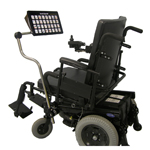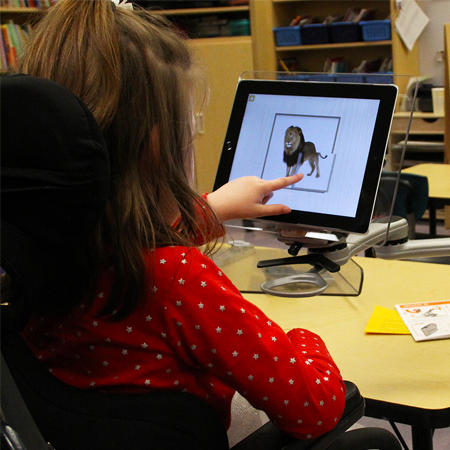Mounting Assistive Technology Part 1: Where To Start
-- by Liza MacLean, OT
 As an occupational therapist specialising in assistive technology, I often get asked the question, how do I mount this communication device or iPad to my wheelchair (or bed or table)? There are many different options for mounting systems that can appear a little overwhelming at the first look! Before even considering mounting systems, you need to start with the user as the first consideration. Any assistive technology should always be matched to the user’s needs and abilities and their other equipment.
As an occupational therapist specialising in assistive technology, I often get asked the question, how do I mount this communication device or iPad to my wheelchair (or bed or table)? There are many different options for mounting systems that can appear a little overwhelming at the first look! Before even considering mounting systems, you need to start with the user as the first consideration. Any assistive technology should always be matched to the user’s needs and abilities and their other equipment.
But before you even start with the user, let’s ask the important question of why do we need mounting?
Many people who need a communication device just think about the actual piece of equipment and what features they need e.g. the language or symbol system, the access options, the size and weight of the device, battery life, speaker quality, the ability to access email or internet etc. What is often forgotten is that one of the most important factors in successful communication device use for people with disabilities is that the user is able to access the equipment reliably. If you can’t reach to press the buttons or screen, the device is moving about, or the eye gaze system can’t track your eyes then it makes it very difficult to use the device to communicate!
 Correctly prescribed mounting systems can ensure that the device is positioned securely and consistently so that the user is able to access it reliably in a variety of positions and environments and during the different tasks they need to perform. It also ensures that the device is safe and won’t get damaged by being dropped or knocked off a table or wheelchair tray, very important for those expensive items!
Correctly prescribed mounting systems can ensure that the device is positioned securely and consistently so that the user is able to access it reliably in a variety of positions and environments and during the different tasks they need to perform. It also ensures that the device is safe and won’t get damaged by being dropped or knocked off a table or wheelchair tray, very important for those expensive items!
It is crucial to spend time not only considering the device features required by the user for their communication needs, but also the features required of the mounting system as well. If the user has a physical disability and needs a new communication device, I would always recommend a joint assessment with a speech pathologist and occupational therapist where possible. It is important that the access options to the device, including how it will be mounted and positioned, are considered at the same time as the device itself. As with all assistive technology, I also recommend try before you buy! It is important to trial the mounting system at the same time as the communication device to ensure that they will work together to meet the needs of the user.
Incorrectly prescribed mounting systems can also cause a hazard to the user. A thorough risk assessment should be carried out when prescribing mounting to ensure that the mounting system is appropriate for the user and the equipment it will be mounted to, and for the purpose and environments where it will be used.
As a first port of call though, if you are a therapist prescribing a mounting system for a wheelchair, I would recommend checking out a risk assessment such as “Mounting Electronic Assistive Technology to Wheelchairs” (link updated 11/07/2017: https://www.nbt.nhs.uk/sites/default/files/attachments/WRAMP%20Assessment%20and%20Risk%20Analysis%20Tool.doc).
This tool was developed by a collection of assistive technology experts in the UK from a range of assessment services calling themselves the “Wheelchair Risk Assessment and Mounting Process Group” or WRAMP and the WRAMP Group's form is a really thorough and clear tool to step you through the risk assessment process. It highlights all the important considerations when prescribing mounting for a wheelchair so can be a guide throughout the entire process.

You'll need a good set of tools and associated equipment for assessment – tape measure (soft and hard), a good allen key set, DAESSY tube measuring tool, a camera to take photos of the wheelchair and potentail attachment points and measurement relationships. A picture tells a thousand words and that's certainly the case when discussing, prescribing or explaining mounting systems to others or for recollection later on.
That's a good place to start. In my next few articles I’ll help you think about the considerations for the abilities and needs of the user, the device that needs to be mounted, and also what equipment it needs to be mounted to. And don’t forget, you can always call the friendly staff at Communicate AT to help point you in the right direction too.
Want to learn more? Follow this link for Mounting and Postioning of Assistive Technology - Part 2: Abilities and Needs.
-- last update 11/07/2017

